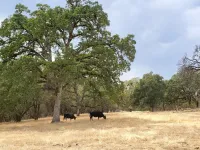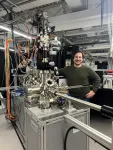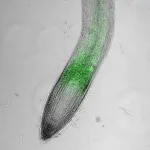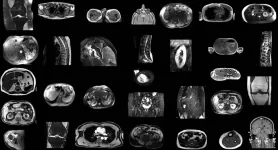(Press-News.org) Researchers tempted grazing cattle with sweet molasses feed to discover whether cows would roam far and wide to graze or stick close to the herd, water supplies and feed stations.
The findings by animal scientists at the University of California, Davis, and published in the journal Scientific Reports, offer a low-cost way for ranchers and others to identify the best cows for their landscapes to optimize grazing while meeting the nutritional needs of cattle.
This is the third in a series of papers about research seeking to better understand the grazing personalities of cattle. The first studies established that the cows weren’t mindless wanderers or followers but had personalities that differentiated how far and wide they would graze, said Kristina Horback, the senior author on the paper and an associate professor in the Department of Animal Science.
“This final study is trying to figure out, ‘Can we have any early indicators so that we don't have to put GPS collars on all cows, but just do a quick practical test?’” Horback said.
Water quality, soil health and habitats can be degraded by cattle grazing unevenly or concentrated in specific areas. A herd with animals that wander around a landscape to graze can benefit the landscape by distributing grazing areas and defecation sites while also reducing fuel loads for wildfires.
Routine checks yield grazing personality
The research took place from June to August over two years at the UC Sierra Foothill Research and Extension Center in Browns Valley. Horback and others tracked 50 pregnant Angus and Hereford beef cows wearing GPS collars across the 625-acre site, which is a mix of grassland and treed areas. The elevation ranged from 600 to 2,028 feet.
Researchers were able to predict cows’ likely grazing personalities by analyzing behavior in situations such as pregnancy checks or vaccinations, which require the cows to walk through chutes or narrow passageways.
At the end of the chutes, the cows had two choices: go one direction to join the herd or another direction to pursue sweet molasses feed placed at different distances. The animals that moved slowly through the chutes and would go out of the way for the feed were consistently the grazing wanderers.
“They were the ones on range that would go far and wide, that would also not really be that motivated to be closely, tightly packed with the rest of the herd,” Horback said.
The homebodies consistently sought out the herd.
“They would not choose that sweet molasses,” Horback said. “They would go right back to the herd as quickly as they could, and then on range, they would just stay together. They have their social group there.”
Future generations
Next up in the research is to see if grazing personalities pass down to later generations. Horback is looking at the female calves of the studied cows to see if they pick up on the same patterns as their moms.
“If there are any calves who are fostered off to another cow, do they pick up the grazing patterns of their birth mom or their adopted mom?” Horback said. “There’s no guarantee that genetics alone will determine the grazing behavior of a cow, but it could increase the likelihood that a cow is a hill-climber or a bottom-dweller.”
She is also working with colleagues in New Zealand and New Mexico to analyze blood samples from the cows that were tracked as part of related studies to see if genetic testing can provide some insight into behavior.
UC Davis emeritus professor Juan Medrano published research a decade ago about genetic markers in cows that could indicate either hill-climbers or bottom-dwellers.
“I hope to build on that knowledge with a larger, international dataset to understand whether grazing personalities are heritable,” Horback said.
Maggie Creamer, who earned her Ph.D. in animal behavior at UC Davis, contributed to the research, which was supported by the Russell L. Rustici Rangeland and Cattle Research Endowment.
END
Sweet molasses feed key to understanding grazing behavior in cattle
Recognizing behavior could optimize herd distribution, enhance nutrition
2025-02-18
ELSE PRESS RELEASES FROM THIS DATE:
Fabio Boschini, first INRS researcher to receive an Alfred P. Sloan Fellowship
2025-02-18
MONTRÉAL and VARENNES, QC, Feb. 18, 2025 /CNW/ - Professor Fabio Boschini is among the 126 recipients announced today by the Alfred P. Sloan Foundation in seven fields. Sloan Fellowships support outstanding early-career scientists who demonstrate creativity, ambition, and dedication to advance discovery. These rising stars of research come from American and Canadian schools and are definitely names to watch. Many Sloan Fellows have gone on to become Nobel prize winners.
INRS Professor Fabio Boschini has just received a prestigious ...
Biomedicine shows the way to future food crops
2025-02-18
University of Queensland researchers have for the first time introduced genetic material into plants via their roots, opening a potential pathway for rapid crop improvement.
Professor Bernard Carroll from UQ’s School of Chemistry and Molecular Biosciences said nanoparticle technology could help fine-tune plant genes to increase crop yield and improve food quality.
“Traditional plant breeding and genetic modification take many generations to produce a new crop variety, which is time-consuming and expensive,” Professor Carroll said.
“We have succeeded in having plant roots absorb a benign nanoparticle which ...
First 5 regions chosen to focus innovative effort on diagnosing, treating CKM syndrome
2025-02-18
DALLAS, Feb. 18, 2025 — Five regions in the U.S. have been selected to implement a new preventive health initiative to improve care for people with a cluster of chronic conditions known as cardiovascular-kidney-metabolic (CKM) syndrome. Through the initiative the American Heart Association, devoted to changing the future to a world of healthier lives for all, aims to increase awareness and screening for CKM syndrome and facilitate collaboration among health care professionals.
CKM syndrome is a clinical term that describes the combined health effects of heart disease, kidney disease, diabetes and obesity, which puts people at high risk for heart ...
Kahramanmaraş earthquake study showcases potential slip rate errors
2025-02-18
Accurate assessment of the land surface damage (such as small-scale fracturing and inelastic deformation) from two major earthquakes in 2023 can help scientists assess future earthquake hazards and therefore minimize risk to people and infrastructure. However, attaining precise extensive measurements in earthquake zones remains challenging.
The two earthquakes that struck on 6 February 2023 were devastating: they were of magnitude 7.8 and 7.6 and occurred in quick succession near the border between Syria and Turkey. They caused widespread infrastructure destruction and resulted in tens of thousands of deaths across multiple provinces.
Using ...
Abortion changes among residents of an abortion rights protective state
2025-02-18
About The Study: This cross-sectional study found a statistically significant increase in abortions for Colorado residents in association with the implementation of Texas SB8. This aligns with reports from area clinicians who experienced dramatic increases in patient demand after SB8, also reported by the media, resulting in delayed appointments for everyone.
Corresponding author: To contact the corresponding author, Kelly A. DeBie, J.D., email kelly.debie@colostate.edu.
To access the embargoed study: Visit our For ...
Tobacco and e-product use by US adults with disabilities
2025-02-18
About The Study: In this survey study, disparities in tobacco use existed across cumulative disabilities. Despite declines in tobacco use over time, differences in use across cumulative disabilities persisted or worsened, especially among those with 3 or more disabilities. Targeted prevention, screening, and cessation efforts inclusive of multiple products are needed.
Corresponding author: To contact the corresponding author, Michael J. Parks, Ph.D., email Michael.parks@nih.gov.
To access the embargoed study: Visit our For The Media website at this link https://media.jamanetwork.com/
(doi: 10.1001/jamanetworkopen.2024.60471)
Editor’s ...
New microactuator driving system could give microdrones a jump-start
2025-02-18
An innovative circuit design could enable miniature devices, such as microdrones and other microrobotics, to be powered for longer periods of time while staying lightweight and compact. Researchers from the University of California San Diego and CEA-Leti developed a novel self-sustaining circuit configuration—featuring miniaturized solid-state batteries—that combines high energy density with an ultra lightweight design.
The results will be presented at the 2025 IEEE International Solid-State Circuits Conference (ISSCC), which will take place from Feb. 16 to 20 in San Francisco.
One important application envisioned for microdrones is ...
Racial disparities seen in same-day breast diagnostic and biopsy services
2025-02-18
OAK BROOK, Ill. – Different sociodemographic groups, especially racial and ethnic minorities, are less likely to receive timely breast cancer diagnostic services after an abnormal screening mammogram, according to a study published today in Radiology, a journal of the Radiological Society of North America (RSNA).
Routine yearly screening mammography is an important first step in the early diagnosis of breast cancer. When a screening mammogram comes back as abnormal, additional imaging and image-guided biopsy may be necessary to diagnose breast cancer.
When it is caught early enough, before symptoms are present, breast cancer can be easier to treat and significantly ...
Researchers develop AI model to automatically segment MRI images
2025-02-18
OAK BROOK, Ill. – Research scientists in Switzerland have developed and tested a robust AI model that automatically segments major anatomic structures in MRI images, independent of sequence, according to a new study published today in Radiology, a journal of the Radiological Society of North America (RSNA). In the study, the model outperformed other publicly available tools.
MRI provides detailed images of the human body and is essential for diagnosing various medical conditions, from neurological disorders to musculoskeletal injuries. For in-depth interpretation of MRI images, the organs, muscles and bones in the images are outlined ...
Racial disparities seen in care after abnormal mammograms
2025-02-18
Despite similar availability of diagnostic technologies to women of different racial and ethnic groups, significant disparities were seen in who actually received same-day diagnostic services and biopsies after abnormal mammogram findings, new research shows. Even when breast-care facilities had the necessary technology and capabilities, minority groups were less likely than white women to receive diagnostic imaging on the same day as an abnormal screening result. Black women in particular were less likely to receive same-day biopsies, compared with white women.
The findings of a retrospective study are to be published ...
LAST 30 PRESS RELEASES:
Scalable and healable gradient textiles for multi‑scenario radiative cooling via bicomponent blow spinning
Research shows informed traders never let a good climate crisis go to waste
Intelligent XGBoost framework enhances asphalt pavement skid resistance assessment
Dual-function biomaterials for postoperative osteosarcoma: Tumor suppression and bone regeneration
New framework reveals where transport emissions concentrate in Singapore
NTP-enhanced lattice oxygen activation in Ce-Co catalysts for low-temperature soot combustion
Synergistic interface engineering in Cu-Zn-Ce catalysts for efficient CO2 hydrogenation to methanol
COVID-19 leaves a lasting mark on the human brain
Scientists use ultrasound to soften and treat cancer tumors without damaging healthy tissue
Community swimming program for Black youth boosts skills, sense of belonging, study finds
Specific depressive symptoms in midlife linked to increased dementia risk
An ‘illuminating’ design sheds light on cholesterol
Who is more likely to get long COVID?
Study showcases resilience and rapid growth of “living rocks”
Naval Research Lab diver earns Office of Naval Research 2025 Sailor of the Year
New Mayo-led study establishes practical definition for rapidly progressive dementia
Fossil fuel industry’s “climate false solutions” reinforce its power and aggravate environmental injustice
Researchers reveal bias in a widely used measure of algorithm performance
Alcohol causes cancer. A study from IOCB Prague confirms damage to DNA and shows how cells defend against it
Hidden viruses in wastewater treatment may shape public health risks, study finds
Unlock the power of nature: how biomass can transform climate mitigation
Biochar reshapes hidden soil microbes that capture carbon dioxide in farmland
Reducing saturated fat intake shows mortality benefit, but only in high-risk individuals
Manta rays create mobile ecosystems, study finds
Study: Mixed results in using lipoic acid to treat progressive multiple sclerosis
Norbert Holtkamp appointed director of Fermi National Accelerator Laboratory
New agentic AI platform accelerates advanced optics design
Biologists discover neurons use physical signals — not electricity — to stabilize communication
Researchers discover that a hormone can access the brain by hitchhiking
University of Oklahoma researcher awarded funding to pursue AI-powered material design
[Press-News.org] Sweet molasses feed key to understanding grazing behavior in cattleRecognizing behavior could optimize herd distribution, enhance nutrition




